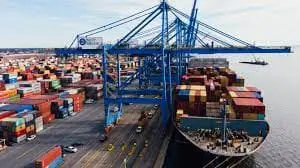What just happened and what to do about it.
Everyone that depends on Ocean Freight for their business is now intimately familiar with the volatility of the past couple of years.
A “Perfect Storm” of factors contributed to send a steady market into a tailspin sending prices and lead times to historical highs.

Container Shortage – 2018 the US government enacted a trade act applying $50 billion additional tariff on goods made in China. For the short term, retailers imported record volumes of goods to have more stock at lower tariffs and used containers as temporary storage space.
Covid 19 – The pandemic closed factories, ports and shutdown economies causing huge workforce disruptions. Containers were piling up in consumer nations as the systems of getting them back in circulation were overwhelmed. Asian manufacturing countries were the first to shut down and the first to reopen but their ability to access shipping was limited container shortages driving the prices to unprecedented heights. Typical 40’ containers that were $3500 prior to covid, spiked at over $25,000.

Labor Shortages – difficulties in recruiting truck and railroad workers has been an issue for over 5 years but was exacerbated by Covid. As freight traffic increased, the ports found nowhere to put containers from vessels as railroad and trucking industries were unable to cope with the volume. The bottle neck forced ocean vessels to anchor at port, sometimes waiting months to unload. What had typically been 35–45-day lead time for freight from Asia, ballooned to anywhere from 70-120 days.
As various contributing factors work through the issues, we’ve seen freight pricing and expected lead times abate towards pre Covid levels.
Will there be a next time?
The one thing we can count on is instability!

Currently, consumer demand is slowing, all the while, new container ships have been ordered by major shipping companies. There will be a “tidal wave” of new ships about to be deployed in mainline trades by the to 10 carriers. While industry insiders predict this could lower rates as shipping companies compete for volume, regardless, the result will be additional instability.
As global events (such as weather, conflict, disease, and market demand) occur, different countries have different reactions/policies which can create interruption in shipping demand, there also creating instability.
No one knows for sure when that next instability event will occur, so how do we prepare?
Determine right now what your least important variable is…do you need your product right now? If so, you will have to pay the market cost. Do you have time to allow your freight forwarder to find an alternative port? If so, you may find competitive pricing.
Find a strong ocean freight company that will work with you as a partner. Build a relationship with this partner and work them now to understand alternatives to your standard routes and routines so that you will know your limits when a crisis hits.
Tetrafab’s Response – We closely monitor transit times and costs so that we can adjust manufacturing schedules accordingly and manage prices to current rates. We consolidate our shipments to further reduce costs that we can pass on to our customers, and we have a close relationship with our freight company that allows us to get real time updates.
Customers of Tetrafab know that we will be here to manage through not only the volatility of shipping but also other pitfalls of import/export such as Customs duty, tariff, quality control of imported goods, as well as up front product development. We are ready to prioritize your project.
